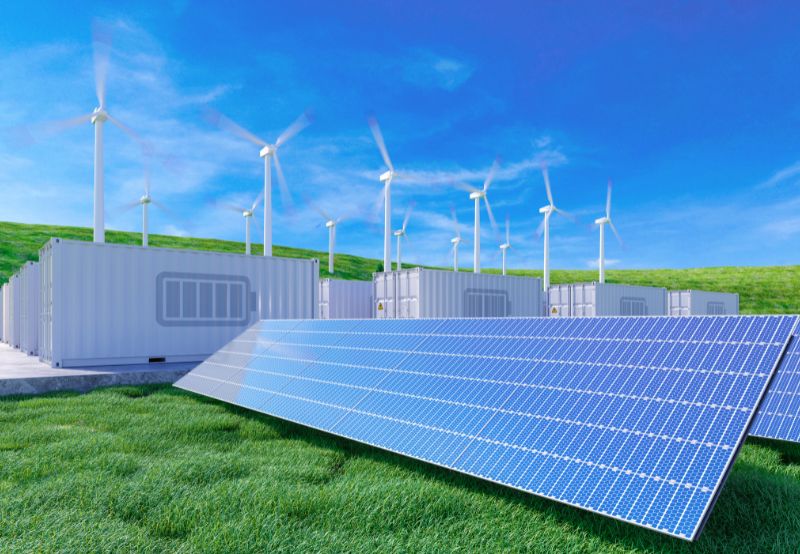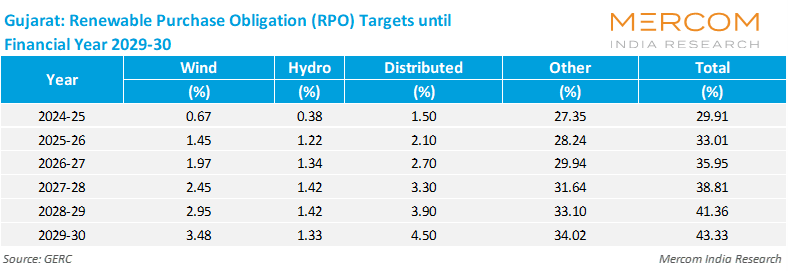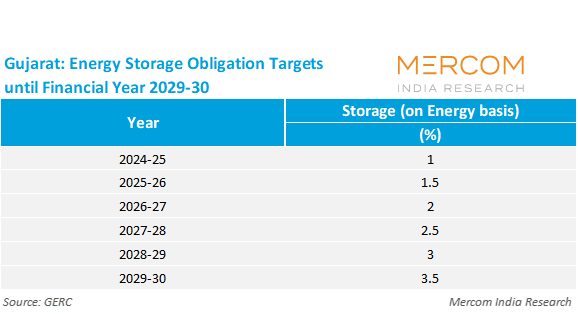Gujarat Regulator Notifies Renewable Energy Procurement Rules Until 2030
The Commission has set RPO and storage obligations for all obligated entities
August 25, 2025
Follow Mercom India on WhatsApp for exclusive updates on clean energy news and insights
The Gujarat Electricity Regulatory Commission (GERC) has issued the GERC (Procurement of Energy from Renewable Sources) Regulations, 2025, governing renewable purchase obligations (RPOs) for distribution licensees, open access consumers, and captive users.
Applicability of RPO
The regulations extend RPO compliance to all obligated entities, including distribution licensees, open access consumers, and captive generating projects with an installed capacity above 100 kW based on conventional technologies.
Captive projects established solely for standby or emergency backup power during breakdowns or power cuts are also covered. Captive users consuming electricity from conventional sources for regular operations must comply as well.
Retail consumers drawing power exclusively from distribution licensees are exempt under the regulations, except where they qualify as designated consumers under the Energy Conservation Act, 2001. Such designated consumers are required to meet their RPO obligations irrespective of the capacity of their captive generation plants.
Quantum of RPO
The regulations specify year-wise RPOs between 2024-2025 and 2029-2030. The quantum is defined in percentage terms of total electricity consumption across wind, hydropower, renewable energy, distributed renewable energy, and other renewable energy.
The regulations specify that the wind component must be met through wind power projects commissioned after March 31, 2024, while the hydropower component must come from hydropower projects, including pump storage and small hydropower, commissioned after that date.
The hydropower quota can also be met through free power allocations to the state from new hydro projects and from energy sourced from projects outside India, if approved by the central government.
Distributed renewable energy is defined as energy from projects under 10 MW, including solar installations across notified configurations, with generation data converted at 3.5 kWh/kW/day where actual metering data is unavailable.
Other renewable energy covers all eligible projects not included in wind, hydropower, or distributed renewable energy, including older wind and hydro projects, biomass, bagasse cogeneration, and municipal solid waste-based power plants.
The regulations allow flexibility to meet shortfalls in wind or hydropower obligations by using surpluses from the other renewable energy category. Surpluses in wind or hydropower can also be counted toward the other renewable category. Excess energy from this category may be used to offset deficits in wind or hydropower.
Obligated entities using open access or captive generation must meet total renewable energy targets irrespective of the source.
Storage Obligation
Alongside renewable purchase requirements, the regulations introduce mandatory energy storage obligations. Obligated entities must procure a percentage of their total consumption through storage. The storage system will be charged predominantly from renewable energy.
The shortage is considered fulfilled only when at least 85% of the stored energy is sourced from renewable energy. The renewable energy stored counts toward total RPO compliance, and the storage requirement is applicable till 2030, with the 2029-2030 levels extended further if no new notification is issued.
Fulfilment and Compliance Mechanism
The regulations mandate that the obligated entities fulfil their RPO category-wise on an annual basis, with quarterly compliance encouraged. Obligations can be met through procurement of renewable energy directly from generators, purchase through exchanges, receipt of free power from government allocations, self-generation from renewable assets, and banking arrangements.
Rooftop solar consumption under net metering or group metering is eligible for compliance either by the consumer or the distribution licensee, per the Gujarat Net Metering Regulations.
Further, renewable energy consumed for producing green hydrogen or ammonia will count towards the RPO of the consuming entity. Any surplus beyond their own obligation will be credited towards the distribution licensee in whose area the project is located.
Obligated entities anticipating shortfalls must procure additional renewable energy or RECs before the end of the year. Inter-category adjustments are allowed within the limits specified in the regulations.
Role of Certificates and State Agency
Certificates purchased from exchanges or traders must be reported to the state agency. Obligated entities can also apply for RECs for surplus renewable energy procured or generated beyond their obligations.
Renewable energy sold under long-term power purchase agreements outside the REC mechanism does not qualify for REC issuance.
The Gujarat Energy Development Agency (GEDA) has been designated as the state agency for implementing these regulations, subject to possible change if the commission finds another agency suitable. GEDA must develop an RPO compliance web portal for registration, monitoring, and reporting by obligated entities.
Quarterly and annual compliance reports must be submitted in formats prescribed by the commission. GEDA can also appoint third-party auditors to verify compliance and will be compensated for its functions under these regulations.
Registration, Reporting, and Monitoring
Obligated entities must register with the state agency through the web portal within three months of notification. They must provide quarterly and annual data on RPO compliance. Distribution licensees must include renewable energy procurement projections for five years in their tariff petitions.
Entities with contract demand above 1 MW and sourcing from conventional sources must file compliance petitions with the commission by June 30 each year, while smaller consumers must report to the state agency.
All obligated entities must also publish the quarterly RPO compliance status on their websites, which will be aggregated on the state web portal.
Penalties
The regulations prescribe financial penalties for non-compliance with the RPOs. The penalty is set at two times the value of per ton of oil equivalent (TOE), as notified by the Ministry of Power. Since one TOE equals 11,630 kWh and the notified value of TOE is ₹21,650 (~$251.74), the penalty works out to ₹3.72 (~$0.043)/kWh of shortfall.
The collected penalties will be placed in a dedicated fund to be used for renewable energy certificate (REC) purchases or for transmission infrastructure development for renewable energy evacuation. In addition, defaults in reporting, false submissions, or failure to submit required information may attract penal provisions.
REC Purchases
Electricity acquired through the REC mechanism, where the buyer does not claim green attributes and the generator takes part in REC trading, will be recognized separately. The purchase rate for such power will be determined by the Commission, considering the average power purchase cost of the distribution licensee.
Recently, GERC approved a tariff of ₹2.60 (~$0.0297)/kWh discovered by Gujarat Urja Vikas Nigam to procure power from 250 MW of solar projects, along with an additional 250 MW under the greenshoe option.
Subscribe to Mercom’s real-time Regulatory Updates to ensure you don’t miss any critical updates from the renewable industry.


